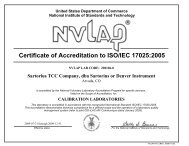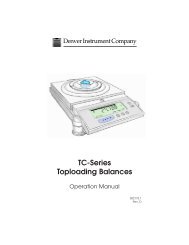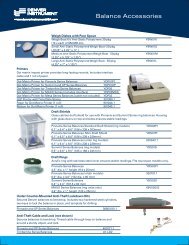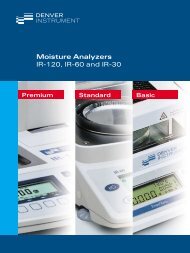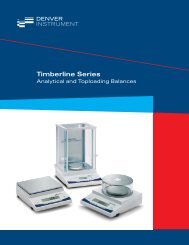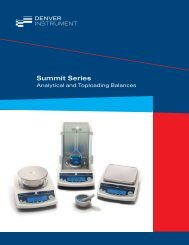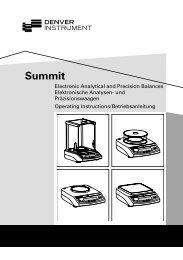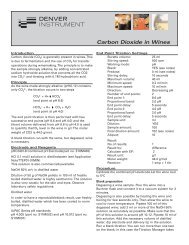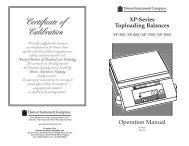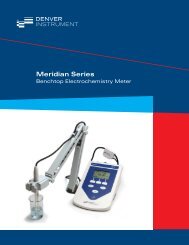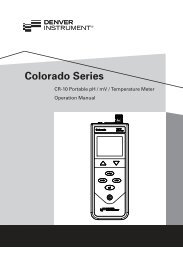UltraBasic Benchtop - Denver Instrument
UltraBasic Benchtop - Denver Instrument
UltraBasic Benchtop - Denver Instrument
Create successful ePaper yourself
Turn your PDF publications into a flip-book with our unique Google optimized e-Paper software.
Rear Panel ConnectorsPower RefInput ATCPowerCableConnectorReference ElectrodeConnector(used with separateReference Electrodes)BNCElectrodeConnectorATC (AutomaticTemperatureCompensation)ProbeConnector4
Installing and Maintaining ElectrodesThis meter allows you to use:• Combination pH electrode with BNC connector• 3-in-1 combination electrode with BNC connector and 2.5 mmphone jack for ATC• Indicating pH electrode with BNC connector and sperate reference• Separate 2.5 mm phone jack for ATC• Ion selective or ORP electrode with BNC connector.1. Remove the protective end coverfrom electrode.2. Before using your pH electrode,or whenever the electrode isdry, soak over-night in anElectrode Filling Solution, KCIsolution or Electrode StorageSolution.3. Remove the shorting cap on the BNC connector. Install the electrode byplugging it into the input connection (push on and twist to lock). Anaccessory ATC probe can be installed in the ATC port for the most accuratemeasurement.Power RefInput ATC5
Power RefInput ATCReferenceElectrode4. If a separate reference electrode is used, plug the reference electrodeinto the ref pin.5. Rinse and blot-dry electrodesbetween each measurement (donot wipe). Rinse electrodeswith distilled water or deionizedwater, or part of the next solutionto be measured.6. Store pH electrodes in KCI solutionor Electrode StorageSolution. Always leave the fillinghole open when in use andclosed when in storage. Refillwith Filling Solution when theinternal solution level gets 1”below fill hole.Note: The electrode that comeswith the <strong>UltraBasic</strong> kit is gel-filled.It has no fill solution or filling hole.6
Using Setup in pH ModeThe setup button lets you clear all the buffers/standards that you haveentered, review calibration information, or select the buffer/standard setthat you want.Note: Continuing to press setup will return you to measurement mode.1. Press setup and the meter displaysa flashing Clear icon. Usethis step only when you wish toclear all buffers you haveentered. To clear all existingbuffers, press enter. The meterclears all buffers and returns toMeasuring screen.2. Press setup again to show electrodeperformance. If the meterhas accepted two buffers, it willdisplay Good Electrode, displaythe slope between the first andsecond buffers and display thetwo buffer icons.pHpH4 7Clear4 7OKsetupsetupmodeentermodeenterstandardizestandardize3. Pressing setup again shows theelectrode slope between thesecond and third buffers (ifthree buffers have beenentered) and shows the secondand third buffer icons.OKpH7 10Note: These screens will only bedisplayed if buffers are stored.setupmodeenterstandardize10
4. Press setup again to display aflashing Set Buffers icon and todisplay the first buffer set (U.S.buffer ser) icons.5. Press enter to select the set ofbuffers shown on the displayorPress setup again to view thenext set of buffers (Merck bufferset). Continue pressing Setup toview the third buffer set (NISTbuffer set).pHpHSetSet2 4 7 10 121 3 6 8 10 13setupsetupmodeentermodeenterstandardizestandardize11
Standardizing for MillivoltMeasurement/ Relative Millivolts(UB-10 Model only)You use millivolt measurement for electrode diagnostics, titration or measuringredox potential (also called ORP, oxidation reduction potential). ORPmeasurements indicate the oxidizing or reducing capability of a solution.You can use ORP values to monitor or control solutions requiring a setamount of oxidants or reductants.1. Immerse electrode in a standardsolution.2. Press the mode button untilyour digital display indicates mVmode.°CSmVsetupmodeenterstandardize3. Press standardize to enter a mVstandard and read relative mV.°C4. When the signal becomes stable,or when you press enter,the current absolute mV valuebecomes zero relative millivolts.°CSmVSrel mVsetupsetupmodeentermodeenterstandardizestandardize12
Using Setup in mV Mode (UB-10Model)1. To clear a mV offset and return toabsolute millivolt mode, presssetup. The meter displays aflashing Clear icon, and showsthe current relative millivolt offset.2. To clear the mV standard, pressenter. You then return toabsolute mV mode.°Crel mVSmVClearsetupsetupmodeentermodeenterstandardizestandardize13
Understanding pH TheoryDefining pHThe measurement of pH plays an important role in identifying andcontrolling acidity and alkalinity levels for industry and research.pH is a measure of the acidity or alkalinity of a solution and can berepresented by this equation:pH = -log [H + ]with [H + ] representing the concentration of hydrogen ions in thesolution. pH is sometimes referred to as the power of the hydrogenion in a solution.By using a pH meter, you can determine exact pH levels of solutions.For example, rather than say that lemon juice is quite acidic,you can say that lemon juice has a pH of 2.4. An exact pH valuecan be used to control or measure acidity levels for manufacturingprocesses or for basic research.pH values generally range from 0 to 14, with a pH value of 7 beingthe neutral point, or the value of pure water. pH values greaterthan 7 represent increasing alkalinity, whereas pH values below 7represent increasing acidity (Figure 1).NeutralStrong AcidLemon JuiceTomato JuiceCoffeePure waterBaking SodaAmmoniaStrong Base0 1 2 3 4 5 6 7 8 9 10 11 12 13 14more acidicpHmore basic14Figure 1.pH Scale showing the relative acidity or basicityof some common substances.
Understanding TemperatureCompensationNOTE: Temperature compensation only takes effect when an ATCprobe is attached.There are two ways that temperature compensation affects pHmeasurement:1. Buffer pH values change with temperature.Each buffer changes depending on the temperature of the solution.These values are typically found on the label of the buffer. Thetables below are representative of most buffers.When standardization is performed in pH mode, the pH value isadjusted to the current value for the current temperature.For example, if your pH 7 buffer isat 20°C the meter will standardizeyour buffer at 7.02 instead of 7.00which is the value at 25°C.2. The electrode efficiency changeswith temperature.The standard mV change per pHunit is approximately 59.17 at 25°C.However, as shown in the belowgraph, this mV per pH unit valuechanges as temperature changes.U.S. Standard BufferpH 4.00 pH 7.00 pH 10.000°C 4.005 7.13 10.345° 4.003 7.10 10.2610° 4.001 7.07 10.1915° 4.002 7.05 10.1220° 4.003 7.02 10.0625° 4.008 7.00 10.0030° 4.010 6.99 9.9435° 4.020 6.98 9.9040° 4.03 6.97 9.8550° 4.061 6.97 9.78The meter compensates for this change by changing the pH readingas temperature changes.electrodepotential(mV)5000100°C (74mV/pH unit)50°C (64mV/pH unit)0°C (54mV/pH unit)isopotentialpoint-5000 7 14Typical pH electrode response as afunction of temperature15
Measuring pHTo measure pH with a conventional glass pH electrode, the meteruses a pH-sensing glass bulb that is sensitive to hydrogen ions.The potential developed at the glass membrane is directly relatedto the pH of the solution.The glass electrode is paired with a reference electrode which completesthe electrical measuring circuit and provides a stable referencepoint. These two electrodes are joined to create a combinationelectrode. The combination glass electrode is connected to thepH meter which reads the voltage, converts it to pH units, and displaysthe result.ATCTemperatureSensorpH SensorPorousJunctionReferenceElectrode16
Troubleshooting1. If the signal from the electrodeis out of range, the display willshow “- - -”. This may happenwhen the electrode is not in asolution.S°CpH2. The meter will display ElectrodeError when it detects an error inelectrode response. During standardization,the message indicatesthat the electrode is lessthan 90% or more than 105% ofthe correct response. TheElectrode Error message canindicate either a bad electrodeor bad buffer(s).pH4 7Errorsetupsetupmodeentermodeenterstandardizestandardize3. If the meter detects an error inthe temperature probe, the displayshows - - -. If you do notuse a temperature probe, themeter uses the default temperatureof 25°C .S°CpH4. To test the pH electrode, place itin a good pH 7 buffer. Pressmode to use the mV mode, andnote the millivolt reading. Makesure the meter is in mV modeand not relative mV mode.Repeat for either a pH 4 or pH10 buffer. The electrode signalmust be within the limits shownbelow (when temperature isnear 25°C).Electrode TestpH 70 ± 30 mVmodesetupstandardizeenterpH 4pH10159 to 186 mVmore than pH 7159 to 186 mVless than pH 717
5. To test the meter for correct operation, install the BNC (input) shortingcap. Press mode to select the mV mode, and note the mV reading. Makesure the meter is in mV mode and not relative mV mode.If the meterreads 0 + 0.3 mV, it is measuring correctly. Note that a long term drift of0.1mV/month since last calibration is specified.Power RefInput ATC18
AccessoriesYou can order the following accessories for your pH meter:Replacement <strong>UltraBasic</strong> pH Electrode 301423.1Plastic-body pH/ATC Electrode 300728.1High-performance glass-body 300729.1pH/ATC Electrode (Tris-compatible)ATC Temperature Probe 300733.1Free-standing Electrode Arm with Base 300401.1Other electrodes, such as ion selective electrodes and redox electrodesare also available. Call your sales representative.Meter SpecificationspH Range 0.00 to 14.00 pHResolution 0.01 pHAccuracy±0.01 pHmV (UB-10 only) Range -1800.0 to 1800.0 mVResolution 0.1 mVAccuracy ±0.2 mV or 0.05%,whichever is greaterTemperature Range 0.0 to 100.0°CResolution 0.1°CAccuracy±0.2°CStandardizationAuto buffer recognition1, 2 or 3 buffers16 buffers2, 4, 7, 10, 121, 3, 6, 8, 10, 131.68, 4.01, 6.86, 9.18, 12.46Auto pH Temperature Compensation with ATC probeAutomatic pH electrode slope correction for 90-105%19
Warranty Instructions1. Please return the prepaid, pre-addressed Purchase Registration Card to<strong>Denver</strong> <strong>Instrument</strong> Company promptly upon your purchase of the <strong>Denver</strong><strong>Instrument</strong> product. The return of the card is not a condition precedent towarranty coverage.2. If you have any questions about a <strong>Denver</strong> <strong>Instrument</strong> product, please contactthe nearest <strong>Denver</strong> <strong>Instrument</strong> office as listed below.3. If it becomes necessary to return your <strong>Denver</strong> <strong>Instrument</strong> product for service,you must obtain a “Return Authorization Number”. Please pack theproduct securely in its original approved packing carton or an other suitablecontainer. Include your Return Authorization Number on the shipping label.Shipping charges must be fully prepaid.Return to authorized distributor or :North and South America: <strong>Denver</strong> <strong>Instrument</strong> Company6542 Fig StreetArvada, Colorado 800041-800-321-1135Tel: 303-431-7255Fax: 303-423-4831U.K. and Ireland:<strong>Denver</strong> <strong>Instrument</strong> Company<strong>Denver</strong> House, Sovereign WayTrafalgar Business ParkDownham MarketNorfolk PE38 9SW EnglandTel: 44 136 63862 42Fax: 44 136 63862 04Europe, Asia and Australia:<strong>Denver</strong> <strong>Instrument</strong> GmbHRobert-Bosch-Briete 1037079 Gottingen GermanyTel: 49 551 20977 31Fax: 49 551 20977 39
North and South America:U.K. and Ireland:Europe, Asia and Australia:<strong>Denver</strong> <strong>Instrument</strong> Company6542 Fig StreetArvada, Colorado 800041-800-321-1135Tel: 303-431-7255Fax: 303-423-4831<strong>Denver</strong> <strong>Instrument</strong> Company<strong>Denver</strong> House, Sovereign WayTrafalgar Business ParkDownham MarketNorfolk PE38 9SW EnglandTel: 44 136 63862 42Fax: 44 136 63862 04<strong>Denver</strong> <strong>Instrument</strong> GmbHRobert-Bosch-Briete 1037079 Gottingen GermanyTel: 49 551 20977 31Fax: 49 551 20977 39www.denverinstrument.com




